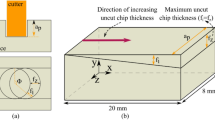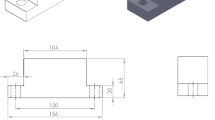Abstract
In this work, a predictive machining theory, based on an analytical thermomechanical approach of oblique cutting (Moufki et al., Int J Mech Sci 42:1205–1232, 2000; Moufki et al., Int J Mach Tools Manuf 44:971–989, 2004), is applied to the peripheral milling process. The material characteristics such as strain rate sensitivity, strain hardening and thermal softening are considered. In the primary shear zone, thermomechanical coupling and inertia effects are accounted for. Due to the fact that the reference frame associated to the primary shear zone moves with the tool rotation, an analysis of the inertial effects has been performed. As the heat conductivity of Ti-6Al-4V is low, the thermomechanical process of chip formation is supposed to be adiabatic; thus, the problem equations are reduced to a system of two non-linear equations which are solved numerically by combining the Newton–Raphson method and Gaussian quadrature. The present analytical approach leads to a three-dimensional cutting force model for end milling operations. Calculated and experimental results extracted from the literature are compared for several operations: full immersion, up-milling and down-milling and for different cutting conditions. Although the present model was established for stationary conditions and for continuous chips, it gives acceptable predictions for machining titanium alloy for which the chips are usually segmented. The proposed model appears as an interesting alternative to the mechanistic approach which requires many experimental tests to determine the milling cutting force coefficients.
Similar content being viewed by others
References
Budak E, Altintas Y, Armarego EJA (1996) Prediction of milling force coefficients from orthogonal data. J Manuf Sci Eng 118:216–224
Martelotti ME (1941) An analysis of milling process. Trans ASME 63:677–700
Koenigsberger F, Sabberwal AJP (1961) An investigation into the cutting force pulsations during milling operations. Int J Mach tool Des Res 1:15–33
Tlusty J, MacNeil P (1975) Dynamics of cutting forces in end milling. Ann CIRP 24(1):21–25
Kline WA, DeVor RE, Zdeblick WJ (1980) A mechanistic model for the force system in end milling with application to machining airframes structures. Proc 8th North Am Manuf Res Conf 8:297
Kline WA, DeVor RE (1983) The effect of runout on cutting geometry and forces in end milling. Int J Mach Tool Res 23(2/3):123–140
Sutherland J, DeVor RE (1986) An improved method for cutting force and surface error prediction in flexible end milling systems. J Eng Ind Trans ASME 108:269–279
Altintas Y, Spence A (1991) End milling force algorithms for CAD systems. Ann CIRP 40(1):31–34
Yucesan G, Altintas Y (1994) Improved modelling of cutting coefficients in peripheral milling. Int J Mach Tools Manuf 34(4):473–487
Dang JW, Zhang WH (2010) Cutting force modeling for flat end milling including bottom edge cutting effect. Int J Mach Tools Manuf 50:986–997
Wang M, Gao L, Zheng Y (2014) An examination of the fundamental mechanics of cutting force coefficients. Int J Mach Tools Manuf 78:1–7
Armarego EJA, Brown RH (1969) The machining of metals. Prentice Hall, New York
Armarego EJA, Whitfield RC (1985) Computer based modelling of popular machining operations for forces and power prediction. Ann CIRP 34(1):65–69
Armarego EJA, Deshpande NP (1989) Computerized cutting models for forces in end milling including eccentricity effects. Ann CIRP 38(1):45–49
Oxley PLB (1989) An analytical approach to assessing machinability. Ellis Horwood
Li HZ, Zhang WB, Li XP (2001) Modelling of cutting forces in helical end milling using a predictive machining theory. Int J Mech Sci 43(8):1711–1730
Li HZ, Li XP (2002) Milling force prediction using a dynamic shear length model. Int J Mach Tools Manuf 42(2):277–286
Moufki A, Dudzinski D, Molinari A, Rausch M (2000) Thermoviscoplastic modelling of oblique cutting: forces and chip flow predictions. Int J Mech Sci 42(6):1205–1232
Moufki A, Devillez A, Dudzinski D, Molinari A (2004) Thermomechanical modelling of oblique cutting and experimental validation. Int J Mach Tools Manuf 44(9):971–989
Bahi S, Nouari M, Moufki A, El Mansori M, Molinari A (2011) A new friction law for sticking and sliding contacts in machining. Tribol Int 4(7–8):764–771
Bahi S, Nouari M, Moufki A, El Mansori M, Molinari A (2012) Hybrid modelling of sliding–sticking zones at the tool–chip interface under dry machining and tool wear analysis. Wear 286–287:45–54
Zorev NN, Massey HSH (1966) Metal cutting mechanics. Pergamon Press
Trent EM, Wright PK (2000) Metal cutting. Fourth edition, Butterworth-Heinemann publications
Ackroyd B, Chandrasekar S, Compton WD (2003) A model for the contact conditions at the chip–tool interface in machining. Trans ASME 125:649–660
Asthakov PV (2006) Tribology of metal cutting. Tribol Int Eng Ser 52:124–212
Filice LMF, Rizzuti S, Umbrello D (2007) A critical analysis on the friction modelling in orthogonal machining. Int J Mach Tools Manuf 47:709–714
Altintas Y (2000) Manufacturing automation: metal cutting mechanics, machine tool vibrations, and CNC design. Cambridge University Press
Meyer HW, Kleponis DS (2001) Modeling the high strain rate behaviour of titanium undergoing ballistic impact and penetration. Int J Impact Eng 26:509–521
Molinari A, Musquar C, Sutter G (2002) Adiabatic shear banding in high speed machining of Ti–6Al–4V: experiments and modelling. Int J Plast 18:443–459
Author information
Authors and Affiliations
Corresponding author
Rights and permissions
About this article
Cite this article
Moufki, A., Dudzinski, D. & Le Coz, G. Prediction of cutting forces from an analytical model of oblique cutting, application to peripheral milling of Ti-6Al-4V alloy. Int J Adv Manuf Technol 81, 615–626 (2015). https://doi.org/10.1007/s00170-015-7018-1
Received:
Accepted:
Published:
Issue Date:
DOI: https://doi.org/10.1007/s00170-015-7018-1




